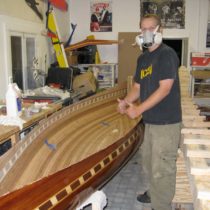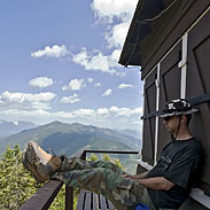Landscape Architecture for Landscape Architects › Forums › GENERAL DISCUSSION › Is America too safe?
- This topic has 1 reply, 7 voices, and was last updated 16 years, 5 months ago by
 Landon Davidson.
Landon Davidson.
-
AuthorPosts
-
July 6, 2009 at 10:28 pm #173772
 ncaParticipant
ncaParticipantReally, the question should probably be what has our legal system and regulatory agencies done for the American landscape?
Being unemployed on the Colorado Front Range is dangerous. It’s easy for someone with a bit of imagination and penchant for adventure to get themselves in trouble in Colorado, especially during the warm months. This weekend I purchased an 8 foot inflatable kayak, some flotation devices, and paddle gear and set out to explore the magnificent high waters of America’s highest state. On both voyages across inland waters I was stopped and turned toward shore by Lake Patrol.
In the first case, my girlfriend and I were not carrying type III PFD’s (personal flotation devices) on board, although we were sure to purchase one for the dog. We politely acknowledged the patrolmen and headed for shore, though the logic seemed skewed being that the inflatable kayak itself had more than three main air chambers, we could both swim and we carried an extra Type IV PFD.
The second incident occurred today at Boulder Reservoir. Again, I was approached as I basked in the sun sketching the front range from a floating dock about 300 yards from shore with my dog at my side and the boat securely tied to the dock. The patrol officer gurgled toward us in his seemingly overkill Boston Whaler. He waved, smiled, and politely explained the rules of the ‘res.’ According to him (he explained with a smirk, as if slightly embarrassed by what he was saying) I had broken several rules punishable by up to a $500 fine. First, I had unknowingly launched from an area restricted to boat launching or swimming, with a dog (all dogs are restricted from the res), and I had not paid ten dollars to have my inflatable 10-fott kayak inspected for mussels (which can cause some ecological damage), even though the boat came out of a box a few days before.
Now, I’m not complaining about any of the specific incidents and I understand the patrollers were just doing their jobs, but at what price does the average American recreational enthusiast pay for what seems like such blatant over regulation of natural resources?
This begs the question, is America too safe? Do we spend too much time, money, and resources planning for disaster? And should we allocate more resources toward planning for more quality experiences, embracing the freedom from which this nation was forged?
Is this the responsibility of the Landscape Architect as steward of experience?
July 7, 2009 at 5:14 pm #173792 Landon DavidsonParticipant
Landon DavidsonParticipantI feel your pain Nick. On more than one occasion I have been scolded for not living up to the REGULATIONS. I think the problem is with the American people. We have let too many activists and politicians decide what is good for us. Granted there should be some protection against people infringing on the rights of others but the nerf world we’ve created is too much.
People need to be left to themselves as long as no one innocent is hurt by it. Then live with the consequences good or bad.
July 7, 2009 at 6:16 pm #173791 Ben YahrParticipant
Ben YahrParticipanti also think the problem is with the american people, but i don’t think we can be to our own devices and assume that no innocent people will be hurt.
the american people, and especially industry, has a terrible record of doing the right thing, doing it safely, and not infringing on the rights of others. i could see Nick’s day going a little bit differently if american’s were left to make their own choices about what was best for them (i.e. quality control, consumer safety, water pollution, invasives, dog poo, etc).
people need to take responsibility for their own actions, be proactive in helping their fellow citizens be responsible and educated about their actions, and most importantly become involved with the creation and maintenance of a small set of regulations to keep everyone safe.
July 7, 2009 at 7:23 pm #173790 Roland BeinertParticipant
Roland BeinertParticipantThat’s true. It seems like no one is willing to take responsibility for their actions. A lot of the regulations seem to be there so no one gets sued when someone does something without thinking. It’s apparently okay to bend the rules and speed along at 80 mph in a 30 mph zone, and anyone who says differently is apparently a communist. But no street trees, since the speeders might lose control and slam into them. Then someone might get sued for installing the tree.
And be careful not to use that blender as a floatation device in a hot oven.July 8, 2009 at 1:18 pm #173789 Ben YahrParticipant
Ben YahrParticipantmy point was quite similar to yours- its very easy to apply these things to ourselves and forget that other people do not do the same. as an avid water sports enthusiast, i almost never carry a pfd- i know i may drown, but i am willing to take that risk. as a dog owner i bring my dog with me to many places posted no dogs- because i know that my dog is under control, and that i will pick up any poo that happens to fly. i fully assume that most landscape architects have relatively similar values to me and would not be a “menace” to the community.
but i don’t think that billybob the weekend warrior has similar values to me. the average american doesn’t care about much beyond the bottom line. simply put, regulations are required to protect us from ourselves, our neighbors, and industry. if we all went to conservation hearings and became active in formulating and maintining the regulations, they would likely be much more logical, trim, and functional.
i generally hate regulations, regulators, and authority figures in general. but i recognize that they are necessary. plus i really don’t want to step in billybob’s poodle poo.
July 8, 2009 at 8:41 pm #173788 Chris WhittedParticipant
Chris WhittedParticipantAt first I thought your post might be more design regulation related – heights before guardrails are required, maximum slopes, allowance of retaining walls, location of detention/retention ponds, etc. In which case I would have said I certainly think so.
But after reading the full post, I can’t so easily agree. This seems more of a freedom of use than a safety thing. Most of the rules and regs are a result of a few people screwing it up for the rest of us, or as others said protection and paranoia (well justified in this day and age) from lawsuits. Which is directly related to the personal accountability and responsibility thing.
To run through your experiences: PFDs – sure you can choose not to take one, but if you have a guest on your boat and there aren’t enough to go around… Hence the requirement that one be available for everyone on board. There are some places (or were) that required not only you have it, but you be wearing it at all times. Launching from restricted areas – shores are fragile places in general, and may be further restricted due to habitat/species protection. You also miss the inspection point if you launch wherever you want. 😉 Dogs are restricted (I believe) because you’re in a municipal water supply – very common around here. Why people are ok and dogs aren’t, or how they deal with wildlife, don’t ask me. As for the zebra mussel inspection, those are regs that aren’t even a year old yet, but the mussels are a HUGE problem and can absolutely destroy a native lake or stream. They’re very easily transported as well. They have no way of knowing if your boat is brand new or what waters you’ve had it in previously, hence the requirement for inspection before putting in or taking out.
From my own experiences, hikers and OHVers need the strict regulations as well to preserve the area for future use. So many times I witness or see evidence of people widening trails to keep their boots from getting a little muddy. Some nearby forest roads are currently closed because of how muddy and easily damaged they are due to the weather, but people have quite literally ripped the closure gates out of the ground or cut fences to drive around. Andrew has another good example of people cutting trees OFF their property in order to open up their views.
Sorry, you’ve hit a passion point of mine. Regulations are needed because people don’t understand or don’t care about the damage they can cause by seemingly harmless acts. I have to strongly disagree with the assessment that it’s ‘blatant over regulation’. I’ve never really heard us described as stewards of experience – just stewards of the land. I don’t see any reason why you can’t have a quality experience in a safe and ecologically sound manner.
That said, Andrew also has another good point in that I am often forced to do the less environmentally sound or friendly thing (for example clearing all existing trees on a site, or using turfgrass instead of wetland plants in detention areas) because of cost, client wishes, or municipal requirements. Sometimes I feel hypocritical as a professional, but I don’t always have a choice.
July 9, 2009 at 5:06 am #173787 ncaParticipant
ncaParticipantJust want to clear a few things up so I don’t look like such a terrible citizen:
Many of the rules relayed to me by the patrol were not clearly posted at trailheads. I know it may sound lame, but I honestly didn’t know that I was breaking some or all of the rules. I just thought I was peacefully and respectfully going swimming with my little boat and dog. I grew up in a place where one could actually do this and it’s still one of the most beautiful natural places I’ve seen, Maine.
My dog is also VERY obedient and docile even. By I see the subjectivity. She actually dosent like to swim.
I launched from a dog swimming area. The north shore allows dogs to swim and poop, but not people. The rest of the res is restricted. The ecological dmage done by myself and my dog to the already tattered beach was negligible at best and pales in comparison to the joeBobs romping and tossing beer cans in the meadows, not to mention the overflowing garbage cans, and fireworks littler and broken glass strewn about.
All I am getting at is, what happened to common sense? I think this reaches well beyond my encounters at the reservoirs.
As a side note, I was more than happy to shell out the extra cash for the jackets and abide by the rules as I see them so long as I may keep my priveleges of enjoying these areas. I don’t necessarily believe I have any unique set of values I’m trying to impose on everyone else, just that there seems to be a degree of common sense lacking which is only further exacerbated by our frivolous misuse of the legal system and political power, I guess. I know I’ll get hammered for that one..
July 9, 2009 at 3:35 pm #173786 Chad CrutcherParticipant
Chad CrutcherParticipantAn interesting thread.
A tip to water enthusiasts regarding PFD’s. I live in Truckee, CA near Lake Tahoe. Last year there was a news story about a middle-aged gentleman in relatively decent physical condition and noted as a good swimmer who was knocked off his boat by a wave and drowned. Why did he drown? He wasn’t going very fast. He didn’t hit his head on anything like a boat hull or get tangled in a water ski rope. He was not wearing a PFD. When he hit the water, it was cold enough to cuase him to reflexively gasp for air. Instead, he sucked his lungs full of water and it took too long to fish him out. I now wear one every time I’m on the Lake.
My second point? If I’m wrong on this, please forgive me, but I never once saw the phrase “public health, safety and welfare” in this discussion. Sure, all the arguments on every side here are dealing with this very issue, but with that phrase at the root of our justifications for demanding licensure, and the respect it brings, I was mildly amused that all these landscape architects are having this conversation without stressing the point. There was one comment referencing guardrail heights that got closest to saying it. We should all know and understand why such regulations exist. We should certainly understand its impact on our profession.
As to justifying our own individual impacts as negligible…please do not forget that there are almost 7 billion of us on this marble. Somebody has to be the adult in the room. That’s what rules are for.
Sucks, don’t it.
July 9, 2009 at 6:15 pm #173785 ncaParticipant
ncaParticipantI think, more than anything, I started this thread to play devils advocate as well. I don’t necessarily disagree with all the regulations at the res, but it did make me think about how much our physical environment is dominated by non-physical barriers and limitations.
I too was hoping this discussion would steer itself toward more of a discussion on design and how the integrity of the landscape experiences we plan may or may not be affected by the regulations that govern such things as railing heights, retaining walls, slopes, and even how we use natural elements such as water and fire.
Is there not some special experiential quality inherent in (semi)dangerous places that seem to draw some portion of the general population closer to the flame, whether it be an unguarded catwalk spanning a shallow bog or a cantilevered viewing deck at the edge of the Grand Canyon?
I could see how in some circumstances the added safety could enhance the experience, though in others it is simply a distraction devaluing it.
I (regrettably) came up with the ‘steward of experience’ title because in a way an architectural designers duty is to advocate or take into account the users experience, in this case; the landscape. I know others will have a different and perhaps more enlightened view of this than me, but I believe it is typically the engineers professional duty to take into particular account the structural and mechanical function and integrity of things first and foremost.
Sure, it is the professional responsibility of the LA to look out for the health, safety, and well-being of the user, but at what cost does an all out pursuit of safety bring to the spirit of the place?
July 9, 2009 at 8:26 pm #173784 Chris WhittedParticipant
Chris WhittedParticipantI don’t think and wasn’t trying to imply you were even a bad citizen, let alone terrible. : ) But you do present a textbook example of why the regs exist and why they are important. They can’t post all the regs at each trailhead because of how many there are – it is your responsibility as a user to know the rules for any given area you plan to use, be it city, state, or national park, or any other kind of public land. But most people don’t research things like that beforehand – I certainly admit I don’t read them all before going somewhere. And like you, I grew up in an area where there was very little regulation. But there were also far fewer outdoor users as well. As for the beach and your launch point, I didn’t know specifics and was just speaking generally. You’re right to question what happened to common sense, but I see it more from the user’s side and not the regulator’s. As a popular commedian has remarked, you can bet every warning label you read is because some idiot tried it. : ) And as Andrew said, it can be very subjective.
July 9, 2009 at 8:34 pm #173783 Chris WhittedParticipant
Chris WhittedParticipantI would have gone into the “public health, safety, and welfare” phrase, but as I originally pointed out that didn’t seem to be the direction of the subject. I personally believe that in the design world we are a bit over-regulated in terms of protecting people from themselves and that whole lack of common sense and personal accountability. And I’d happily participate in such a discussion. But this was headed more toward land use policy and regulation which is as much or more about protecting the resource and environment than the people using it (PFDs aside).
July 9, 2009 at 8:55 pm #173782 Chris WhittedParticipant
Chris WhittedParticipantI think your third paragraph really hits home on the crux of at least one major issue that spans both land use and design considerations when it comes to regulations and safety. Some of our (people in general, not just LAs) work and technology has lead to an increase in the accessibility of places that are inherently more dangerous. I think in some cases this allows people who are not experienced, equipped, or prepared enough to visit these places and get into situations they normally wouldn’t be able to. Oh the stories I could tell.
This access can also create a false sense of security. And the misconceptions about improvements made – your catwalk for example isn’t there to protect the user, it’s to protect the bog; unlike in a more urban setting where it’s for the user to be able to cross a stream and would be expected to have rails. Obviously the setting/place have significant influence over what could be defined as ‘safe.’ What is the lowest common denominator when it comes to ‘protecting’ the HSW of the general public, and is that really what we should always design to?
I’m not touching the engineer subject here. Suffice to say that’s a stereotype, their roles are changing, and they say some of the same sorts of things about LAs (and we can even through architects into the mix if you want to really have fun.) : )
July 10, 2009 at 1:24 am #173781 ncaParticipant
ncaParticipantI know it’s a stereotype, and maybe I overstated the point, again.
But I think if you look at it in terms of professional priorities; the LA is concerned with the interface of people and things first, while the engineer is concerned with the interface of things and things first. Maybe this is a stereotype, but I can only speak from personal experience, which is admittedly limited. Having someone with an engineering background in this or other discussion may prove helpful.
I think you point makes sense Chris; context is key.
Here’s another tangent; I wonder if it would be possible to correlate health issues such as obesity and even psychological nonconformities (I hate the term ‘disorder’) to the level and standards of HSW and access to wild places?
July 11, 2009 at 7:08 pm #173780 Chad CrutcherParticipant
Chad CrutcherParticipantInherent danger has been translated by lawyers into attractive nuisance. Your point approaches the edge of liability thinking…should we as designers promote danger as a planned experience? Of course amusement rides have played to this psyche, but always within the constraint of public health and safety. Within the necessary confines of civilized society’s regulatory context, it is difficult to imagine a liability-free way to provide inherently dangerous experience, the definition requiring very real threat of bodily harm and/or death, with intent (read: by design).
A very, very interesting topic of discussion, indeed. Let me ask you this: How would you do this, if you could? And, more importantly, why?
July 12, 2009 at 1:12 am #173779 ncaParticipant
ncaParticipantWell,
I think the easiest way to incorporate this kind of experience would be to actually distill some of the places we make. It’s been a long day and I know that probably isn’t the best verbage. In other words, maybe not incorporating guard rails along steep embankments, fo example. I think there’s certainly an appropriate time and place to try this, if it were possible.
My girlfriend and I visited ‘Water World’ all day today- a water amusement park with slides, chutes, pools, and waves.
We had a ton of fun, but I couldn’t help thinking about this discussion. There were so many ways I could have cracked my skull on the side of the ‘Inside the Earth’ waterslide or drowned in the wave pool, but there were also so many restrictive elements, albeit minor, which I think detracted from the experience for thos paying attention. For instance, The wave pool which was styled to resemble a beach included a ‘freestanding’ 18″ CMU block wall separating the sloping beach from the pool area. To get to the water or beach you had to step on and over the slippery painted wall. It was awkward in my opinion, but probably there to enclose the beach so that toddlers could not wander into the wave pool??
I guess my next point is that it’s troubling to know that the regulation and codes may not necessarily be so concerned with protecting the HSW of the gen public so much instilling that somewhat illusory sense of safety.
I watsched as park goers in front and behind me death-gripped the handrail on the way up the 60-foot tower feeding the parks tallest slide, peering over the presipice with grins. I joked to my girlfriend that these rides are getting a little outdated given all the action sports occurring and the risks involved and that the thrill rides weren’t so thrilling as they once were ten or twenty years ago. I joked that one day there may be a ‘leap to your death ride,’ where park goers would, just as climbing the tower to the steep water slides, climb a tower and leap to the concrete from beside a sign reading’ leap at your own risk, park assumes no responsibility for injury or death,’ even though the tower includes the same 42″ rails and slip-proof stair treads.
I guess the reason why I think it may be important to build in some natural level of danger or risk is to slow the seemingly evolutionary human digression toward global ‘nerfism’ as another member here put it.
Perhaps what I’m getting at in a roundabout way is the question of whether the natural human emotion of fear is the most neglected in the 21st century?
-
AuthorPosts
- You must be logged in to reply to this topic.


